Are you a beginner wondering whether the Hampta Pass Trek will suit you? The answer is yes. If you are healthy, physically fit, and mentally prepared to take on the varied challenges of this Himalayan Pass, you should definitely make it your first trekking destination.
Hampta Pass is a high-altitude ridge in the Pir Panjal range of Himachal Pradesh. Located at 14,100 ft, it connects the Kullu Valley with Lahaul Valley, marking a transition zone between their contrasting topography. As a beginner, this trek will introduce you to almost all the features of Himalayan geography. From the fast-flowing Beas River, forest trails, waterfalls, and meadows to barren slopes, bouldered regions, an alpine lake of Chandratal, and snowy tracks, you will experience it all in one place.
Ready to take on the challenges of this moderate-level trek? Scroll down to understand the best time for trekking, difficulty analysis, and preparation tips for the Hampta Pass Trek.
Table of Contents
Hampta Pass Trek: A Scenic Crossover
The scenic beauty of the Hampta Pass Trek is one of a kind, with landscapes changing from lush green at Kullu to an alpine desert near Chandratal. Every stop and campsite on this hike feels like stepping into a Himalayan wonder. The beauty of Manali, Rani River, Chandratal, and the meadows of Jwara all combine to make the Hampta pass trek a must-do for adventure and nature lovers.
Let us have a detailed look at some of its unique features:
Location and Geographical Significance
The real highlight of the Hampta Pass Trek is its ideal location, which serves as the transition zone between the renowned Kullu Valley and the Lahaul-Spiti region. This circuit trek not only involves crossing the pass but also takes you through Chandratal and Chatru Village, both of which hold geographical significance. Chandratal was designated as a Ramsar Wetland Site in 2005, while Chatru Village marks the intersection of Rohtang, Spiti, and Hampta. Historically, this was a trade route used by shepherds, and it now supports tourism in Himachal Pradesh with its adventurous trails.
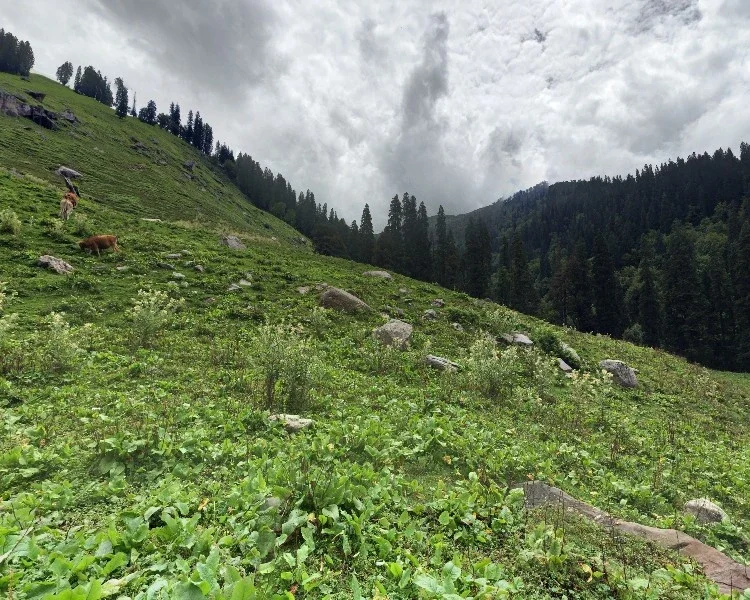
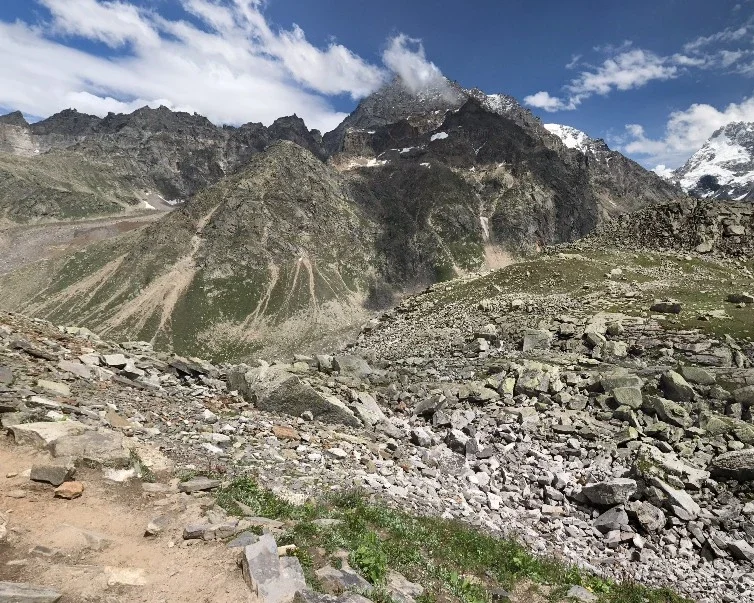
Lush Valleys at Jobra, Chika, and Balu Ka Ghera
Your Hampta Pass Trek starts with the scenic drive from Manali to Jobra, the base camp of this trek. Here, you will be greeted by dense forests of pine and birch trees. As you move forward towards Chika, the gushing Rani Nallah, surrounded by the Pir Panjal Range, washes away your tiredness. The Chika campsite offers you open meadows with scenic views of Jwara and its waterfalls.
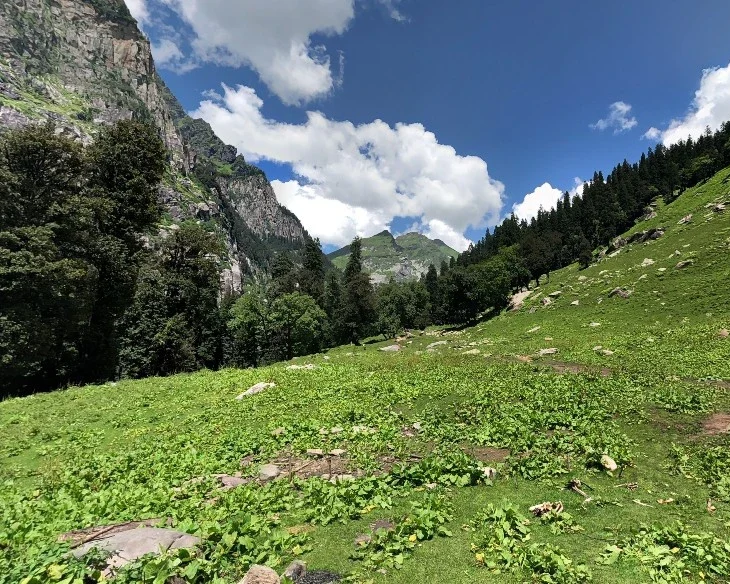
The next day, you will arrive at Balu ka Ghera (Bed of Sands), which gives you a unique camping experience in the U-shaped Valley surrounded by the Pir Panjal ranges. Throughout the first half of your itinerary, you will witness a riot of colours carpeting the valleys with Himalayan knotweed, Honeysuckle, and other colourful plants, making the scenery lively with their presence.
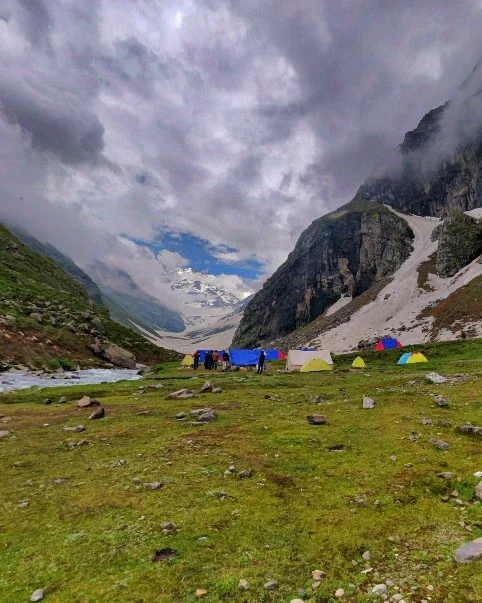
Crossing High-altitude Pass (14,100 ft)
On day 3, you will finally tackle the ascent to Hampta Pass itself. This snow-covered and bouldered corridor remains blanketed in white even during summer months in patches. As a beginner, walking over the snow will surely excite you. The experience of standing on this towering pass, you encounter what I call the “top of the world” moment. This gives you a mix of accomplishment, awe, and humility as panoramic views unfold in every direction. The Dhauladhar range stands proud on one side while the Pir Panjal mountains dominate the other horizon.
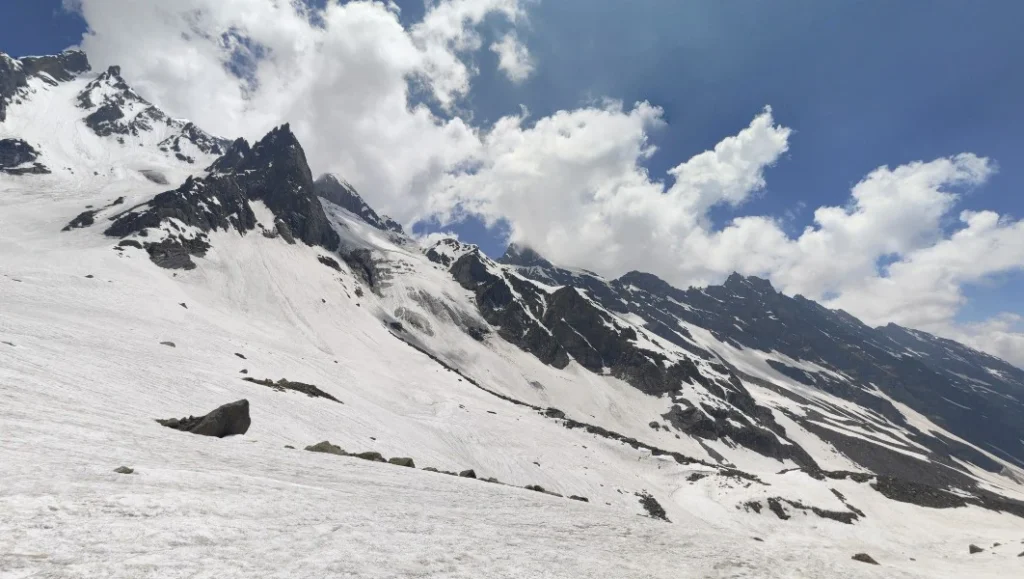
Stark Contrast in Landscape
This feature makes Hampta Pass special, providing a wholesome Himalayan trekking experience in one place. You will see lush vegetation swaying with colorful wildflowers on the Kullu side of the trek. The landscape gradually transitions to a dry, barren, alpine desert-like moonscape as you descend towards Lahaul Valley. This change in scenery is because Kullu lies on the windward side of the mountain range, while Lahaul-Spiti lies in the leeward region, receiving less rainfall.
Why the Hampta Pass Trek is Perfect for Beginners?
While Manali and Kullu Valley are popular tourist destinations for Indians, many still don’t realize that a beautiful trek like the Hampta Pass can be easily attempted by complete beginners. I mentioned complete beginners, but it includes those who are physically fit, healthy, and well-prepared for the challenges of this trek. Whether you are a young and dynamic trek enthusiast or a senior citizen who has maintained good physical health, here are the top reasons that make Hampta Pass your perfect destination:
- Moderate difficulty level that challenges without overwhelming: The trail includes varied terrain from gentle forest paths to some steeper sections near the pass. It does not include any technical sections, and most of the tricky terrain can be crossed with good guidance.
- Manageable duration of 4-5 days: You can easily fit the Hampta Pass trek into your vacation. This mid-range duration prevents mental and physical fatigue while attempting this expedition-like trek.
- Challenging yet accessible trails: Given that you will have a local guide by your side and will be travelling with a group, even the most challenging trails will become enjoyable. These are well-maintained and easy to navigate with a consistent pace.
- One of the best monsoon treks in India: While most of the Himalayan treks remain inaccessible during the rainy season, the Hampta Pass offers an unparalleled opportunity to witness the magic of monsoons in the region.
Best Time to Visit Hampta Pass For Beginners
As mentioned earlier, the Hampta Pass trek is a monsoon trek. Therefore, the best time to attempt this trek is between June and September. Till May, the region experiences harsh winters with snow and hailstorms, even during June, you will find thick snow patches blanketing the higher altitudes of the pass. Post September, October marks the onset of winter, making it inaccessible for trekking due to extreme snowfall blocking the trails. Below, I have provided a detailed analysis of weather conditions at Hampta Pass to help you pick the best time that suits you well:
Ideal Months: Mid-June to September
Like most treks on the Pir Panjal ranges, the Hampta Pass is a monsoon trek. This means you can enjoy the freshness and misty beauty of its forest trails set against the backdrop of fog-veiled mountains and dark grey skies on the Kullu side. On the Lahaul side, you will witness the brimming Chandratal, which reflects the beautiful sky and colourful sunsets in its emerald water.
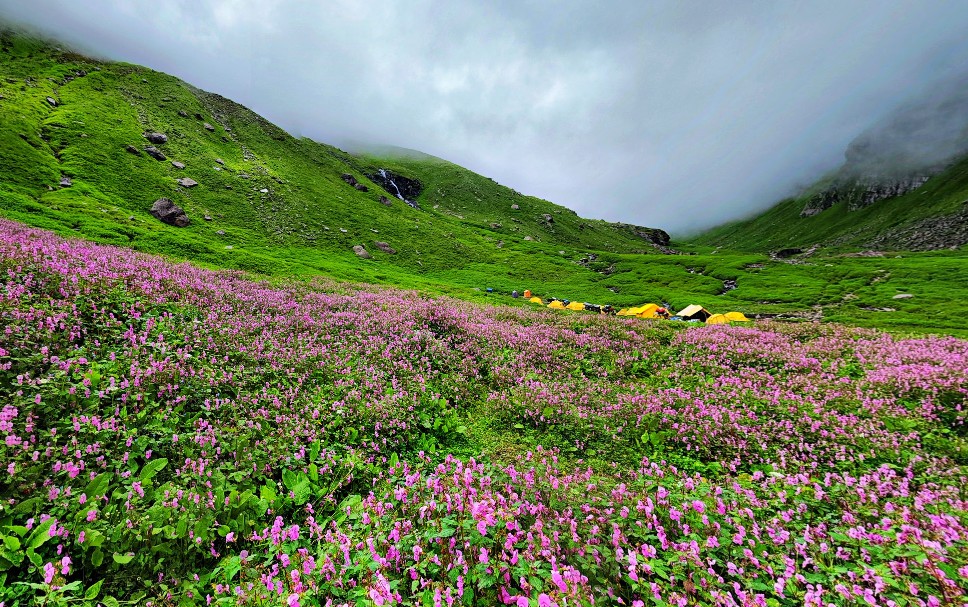
The table below gives an overview of what each month brings to the Hampta Pass Trek and what you can expect:
| Month | Avg. Temperature | Trail Conditions | Scenery | Difficulty |
| Mid-June | Day: 18°C Night: 7°C | Snow accumulation on the trails | Wildflowers begin to bloom, clear skies | Moderate (some snow navigation) |
| July | Day: 15°CNight: 5°C | Occasional rain on the Kullu side, wet trails | Peak greenery, rushing streams, cloudy, Vibrant flora | Moderate-challenging (slippery sections) |
| August | Day: 14°C Night: 4°C | Some rainfall, well-defined trails | Lush valleys, dramatic cloud formations | Moderate (rain gear essential) |
| September | Day: 12°C Night: 2°C | Dry trails, less rainfall, occasional early snow | Clear mountain views, autumn colors beginning | Moderate (cooler temperatures) |
Each period within the trekking season offers distinctive experiences for adventurers:
June to July
June marks the arrival of summer in the Hampta Pass region, with melting snow in its glacial valleys. The trekking conditions become favourable, and you will notice vegetation unfurling slowly as winters retreat. During the day, the temperature remains pleasant, however, the mercury may drop at night. Above 12,000 ft, you may still find residual snow during this time, giving you the ultimate Himalayan trekking experience.
July brings unpredictable rainfall on the trails to the pass, with overall comfortable weather, safe for trekking activities. If you are planning this trek with family, this is the ideal time for you.
August to September
August brings the peak monsoon season in the Kullu Valley, with clean and crisp air enveloping the entire region. The valleys become so green and colourful that they resemble the famous Valley of Flowers of Uttarakhand. This is the best time to visit the Hampta Pass if you want to witness the dramatic contrast in the landscape and love the thrill of trekking.
With September, the rains become scanty and sparse, bringing the early autumn. The verdant valleys become even more colourful with tints of yellow and brown on the grass. This month marks another safe season to attempt the trek with a lesser risk of slippery trails and picture-perfect scenery for photography enthusiasts.
Note: Avoid winter months (November through April and May) when heavy snowfall makes the pass difficult to traverse. The extreme cold during this period creates dangerous conditions even for experienced mountaineers.
Is Hampta Pass Tough for Beginners?
If you are wondering, can I do the Hampta Pass trek as a complete beginner? The answer is yes if you are reasonably fit and have prepared thoroughly for it. This moderately difficult trek will surprise you with some of its beginner-friendly features, such as:
- It has a well-maintained trail system that runs along the natural contours of the mountains, making it easier for you to cross them under guidance.
- You will walk for approximately 6 to 8 km daily, allowing plenty of time to rest and acclimatize.
- The trek’s trail difficulty builds gradually, giving your body time to adjust before facing the rugged sections.
- Another feature that adds to the Hampta Pass trek’s accessibility is its infrastructure. Throughout the trekking season, you will get experienced guides leading groups regularly.
Factors That Make the Hampta Pass Trek Difficult
Whether you are an adventurous beginner or a seasoned trekker, I would suggest that you learn about the specific challenges that Hampta Pass offers. This helps you prepare mentally and physically before you venture on this journey. Let us discuss the difficulty factors of the Hampta Pass trek based on my experiences and feedback from trekkers with varying experience levels.
- Altitude Analysis:
Starting from Manali at 6,400 ft, you climb to 9,800 ft at Jobra and further to 10,100 ft at Chika on the first day itself. Over the next 2 days, you climb to 14,100 ft at Hampta. This gradual ascent helps you adjust to the high altitude. However, the thin air and low oxygen at the top may pose some difficulty with the risk of Acute Mountain Sickness (AMS) above 12,000 ft.
- Steep Sections:
The Hampta Pass trek includes some trail sections with steep gradients that demand stamina and mental preparedness. When you start from Balu ka Ghera to Hampta Pass, you will cross an extremely challenging, steep section with an equally demanding descent towards Chandratal from the pass. This trail section requires you to attempt an uphill hike over loose scree and slippery patches of snow. I remember many of my fellow trekkers resting on the rocks, and we even slid through the snow patches using a rope to make it easier.
- Weather Changes:
Given the high altitude of this Himalayan pass, the unpredictable nature of the weather adds another layer of challenge for beginners. The weather can take a turn at any point in time. You may wake up to a bright sunny morning, and towards the afternoon, it may rain heavily. If you are travelling in June, chances are you may even experience a hailstorm on the Hampta Pass trek.
Since it is a monsoon trek, expect heavy mist and occasional rainfall during the months of July and September. However, my experience says to take extra mindful steps near Balu ka Ghera during such risky weather to avoid any injuries. Make sure to keep yourself dry and warm if you get wet; the risk of hypothermia increases during such times.
Hampta Pass For Beginners: Trek Preparation Tips
So, you are an adventurous traveller who is all set to experience the thrill of breathtaking valleys, camping under starry nights, and crossing a Himalayan pass. But, are you really prepared to take on the challenges that the Hampta Pass Trek throws at you? You may have watched many vlogs or read detailed blogs on how to tackle these trek difficulties. The actual difficulties you will face will be unique to your experience and require well-planned mental and physical preparation.
Below, I have given some of the practical tips that you must keep in mind for a smoother trekking experience in Hampta Pass:
- Make cardio exercises a daily habit: Crossing the continuous steep sections of the Hampta Pass requires good cardiac strength. To ensure you are physically prepared, start with jogging and move to running. Target to cover 5 km in 35 minutes before two weeks of your Hampta Pass Trek. Eventually, include resistance training in your exercise routine to train your muscles to reduce the risk of injuries.
- Include buffer days: This trek gains rapid elevation. Hence, adding an extra day to the itinerary helps your body adjust to it easily. You can stay in Manali for a day and explore this hilly town for acclimatization. Keep a proper check on any AMS symptoms at each campsite to alleviate any serious health problems
- Warm-up and cool down exercises: These exercises are important and provide the added benefit of preparing your body before facing the challenges of the Hampta Pass Trek. Before hitting the trails and after reaching the campsite, you can perform light exercises to relax your muscles. Personally, I find Surya Namaskar and similar yoga poses beginner-friendly and effective as warm-up and cool-down routines.
- Pack smart and light: Try to pack light and carry only essentials. High-quality trekking boots, moisture-wicking clothing, fleece-lined inners, a reusable water bottle, and an extra pair of slippers to cross water streams are an absolute necessity. Additionally, I recommend carrying a headlamp, personal medical kit, toiletries, sunscreen, cap, and an extra pair of socks for your added comfort.
- Hydration is the key: The cold temperatures or moist air during the Hampta Pass Trek may make you feel less thirsty even after hiking for long distances. You must keep a check on your water intake, and do not forget to drink directly from pristine water streams like Rani Nallah on your way up. Remember to carry ORS to supplement the minerals in water, helping you prevent cramping.
- Carry high-protein snacks: While you will be provided with proper meals by us throughout this trek, I suggest you bring your favourite snacks. These can be protein-rich energy bars, roasted nuts, dried fruits, or even chocolates to give that extra boost when mental fatigue clouds you.
- Maintain a steady pace: As a beginner, you may find it difficult to match the pace of experienced trekkers in your group. Instead of rushing, you must aim to keep a consistent speed that does not lead to burnout or exhaustion at high altitudes. Be very mindful of your footing while traversing the pointy, rough, and loose scree and rock sections.
- Good quality trekking gear: These play a major role in making this challenging trek easier for you as a first-timer. You must carry an ergonomic 50 L water-resistant backpack, trekking poles, and gators or microspikes for crossing snowy tracks. Alternatively, you can also rent these from us or a market in Manali.
- Hire a guide and porter: This is not necessary for experienced trekkers, but as a beginner, I suggest you hire a trekking guide for your group. This will help you stay confident while crossing tricky sections near Balu ka Ghera and Hampta Pass. Additionally, having a porter with mules take your camping gear and luggage uphill reduces the physical and mental strain on you.
- Get your permits ready: Hampta Pass comes under the protected forest zone of the Himachal Pradesh Forest Department. If you are an Indian National, you must acquire a forest entry permit and camping permission, which come with a nominal fee and require a valid ID proof. For foreigners, you must bring a valid ID proof with a passport, and you may also need an Inner Line Permit to trek in the Lahaul region.
- Book with a registered travel operator: This is the best advice I can give you if Hampta Pass is your first trekking adventure. These operators make the experience smoother by handling your permits, camping, and food facilities throughout your itinerary.
- Follow the Leave No Trace policy and respect the locals: As a responsible trekker, this is very important to maintain the beauty of the Hampta Pass trek. Carry extra plastic pouches to avoid littering, walk on designated trails, and follow the rules defined by your guide.
Wrapping Up
The reward-to-effort ratio of the Hampta Pass Trek makes it a perfect trekking destination for many beginners. Yes, it is challenging, but after crossing each difficult trail on the trek, you have a never-before-seen kind of Himalayan scenery waiting for you. Standing atop this high-altitude pass, looking over the expansive Lahaul Valley with Indrasen Peak and Hanuman Tibba, fill your heart with a great sense of achievement.
Want a reliable partner that makes this tricky yet fulfilling journey worthwhile? Book with Himalayan Dream Treks, one of the most trusted tour operators in Uttarakhand, for a smoother trekking experience! Contact us at info@himalayandreamtreks or +91 80896 93825.
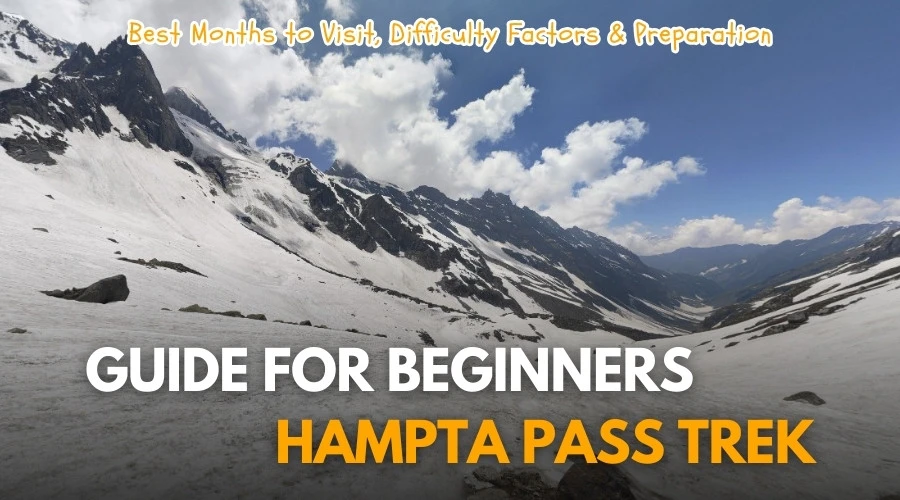
Leave a Comment